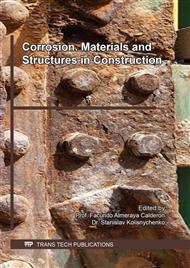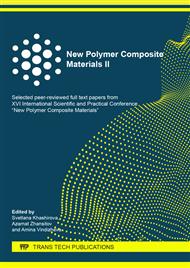[1]
V.F. Stepanova, A.Yu. Stepanov, E.P. Zhirkov, Composite polymer reinforcement, Bumazhnik, Moscow, (2013).
Google Scholar
[2]
A.M. Umansky, T.A. Becker, The prospects for the use of composite reinforcement, FEFU: School of Engineering Bulletin. 11 (2012) 7-13.
Google Scholar
[3]
H.A. Hejew, Y.V. Puharenko, Gypsum concrete composites reinforced with basalt fibers, Bulletin of Civil Engineers. 37 (2013) 152-156.
Google Scholar
[4]
N.M. Ali, X. Wang, Z. Wu, A.Y. Hassanein, Basalt fiber reinforced polymer grids as an external reinforcement for reinforced concrete structures, Journal of reinforced plastics and composites. 34 (2015) 1615-1627.
DOI: 10.1177/0731684415594487
Google Scholar
[5]
E.A. Ahmed, E.F. El-Salakawy, B. Benmokrane, Performance evaluation of glass fiber-reinforced polymer shear reinforcement for concrete beams, ACI Structural journal. 107 (2010) 53-62.
DOI: 10.14359/51663388
Google Scholar
[6]
G.A. Gizdatullin, R.R. Khusainov, V.G. Khozin, N.M. Krasinikova, Strength and deformability of concrete structures reinforced with fibre-reinforced polymer bars, Magazine of Civil Engineering. 2 (2016) 32-41.
DOI: 10.5862/mce.62.4
Google Scholar
[7]
Z. Lu, L. Su, J. Xie, G. Xian, B. Lu, Durability study of concrete-covered basalt fiber-reinforced polymer (BFRP) bars in marine environment, Composite structures. 225 (2019) 111650.
DOI: 10.1016/j.compstruct.2019.111650
Google Scholar
[8]
M. Inman, E.R. Thorhallsson, K. Azrague, A mechanical and environmental assessment and comparison of basalt fibre reinforced polymer (BFRP) rebar and steel rebar in concrete beams, Energy Procedia. 111 (2017) 31-40.
DOI: 10.1016/j.egypro.2017.03.005
Google Scholar
[9]
W.-K. Hong, H.-J. Ko, S.-C. Park, G.-T. Lim, J.-H. Kim, J.T. Kim, Reduction effect of toxic substances for apartment buildings with an ecofriendly pre-cast composite structural system, Indoor and Built Environment. 22 (2013) 110-116.
DOI: 10.1177/1420326x12469706
Google Scholar
[10]
P. Archbold, G. Tharmarajah, Evaluation of corrosion-resistant basalt-fiber-reinforced polymer bars and carbon-fiber-reinforced polymer grid reinforcement to replace steel in precast concrete underground utility vaults, PCI Journal. 61 (2016) 69-76.
DOI: 10.15554/pcij61.5-02
Google Scholar
[11]
H.R. Hamilton, B. Benmokrane, C.W. Dolan, M.M. Sprinkel, Polymer materials to enhance performance of concrete in civil infrastructure, Polymer reviews. 49 (2009) 1-24.
DOI: 10.1080/15583720802656153
Google Scholar
[12]
Y.B. Potapov, S.A. Pinaev, A.A. Arakelyan, A.D. Barabash, Polymer-cement material for corrosion protection of reinforced concrete elements, Materials Science Forum. 871 (2016) 104-109.
DOI: 10.4028/www.scientific.net/msf.871.104
Google Scholar
[13]
A.E. Naaman, Progress and prospects of FRP reinforcements: survey of expert opinions, Fibre-Reinforced Polymer Reinforcement for Concrete Structures. (2003) 25-36.
DOI: 10.1142/9789812704863_0002
Google Scholar
[14]
V.F. Stepanova, Prospects of composites application in the production of concrete and reinforced concrete, Concrete Technologies. 110-111 (2015) 8-9.
Google Scholar
[15]
V.N. Haruna, A.S. Abdulrahman, P.T. Zubairu, L.O. Isezuo, M.A. Abdulrahman, D.C. Onuoha, Prospects and challenges of composites in a developing country, ARPN Journal of Engineering and Applied Sciences. 7 (2014) 1069-1075.
Google Scholar
[16]
S.V. Klyuev, T.A. Khezhev, Y.V. Pukharenko, A.V. Klyuev, To the question of fiber reinforcement of concrete, Materials Science Forum. 945 (2019) 25-29.
DOI: 10.4028/www.scientific.net/msf.945.25
Google Scholar
[17]
D. Jacques, L. Wang, E. Martens, D. Mallants, Modeling chemical degradation of concrete during leaching with rain and soil water types, Cement and concrete research. 40 (2010) 1306-1313.
DOI: 10.1016/j.cemconres.2010.02.008
Google Scholar
[18]
S.V. Fedosov, V.E. Rumayntseva, V.S. Konovalova, I.V. Karavaev, Liquid corrosion of concrete in the environment with various degree of aggressiveness, Bulletin of Civil Engineers. 63 (2017) 113-118.
Google Scholar
[19]
S.V. Fedosov, V.E. Roumayntseva, I.V. Krasilnikov, V.S. Konovalova, Physical and mathematical modelling of the mass transfer process in heterogeneous systems under corrosion destruction of reinforced concrete structures, IOP Conference Series: Materials Science and Engineering. 456 (2018) 012039.
DOI: 10.1088/1757-899x/456/1/012039
Google Scholar
[20]
S.V. Fedosov, V.E. Roumayntseva, I.V. Krasilnikov, V.S. Konovalova, A.S. Evsyakov, Monitoring of the penetration of chloride ions to the reinforcement surface through a concrete coating during liquid corrosion, IOP Conference Series: Materials Science and Engineering. 463 (2018) 042048.
DOI: 10.1088/1757-899x/463/4/042048
Google Scholar
[21]
N.K. Rozental, V.F. Stepanova, G.V. Chekhny, About maximum admissible content of chlorides in concrete, Construction materials. 1-2 (2017) 82-85.
Google Scholar



